Society for California Archaeology 2010 Annual Meeting
Society for California Archaeology 2010 Annual Meeting
Society for California Archaeology 2010 Annual Meeting
Create successful ePaper yourself
Turn your PDF publications into a flip-book with our unique Google optimized e-Paper software.
<strong>Society</strong> <strong>for</strong> Cali<strong>for</strong>nia <strong>Archaeology</strong> <strong>Annual</strong> <strong>Meeting</strong> <strong>2010</strong> 43<br />
ARKUSH, Brooke<br />
Weber State University<br />
Native Responses to European Intrusion: Cultural Persistence and Agency Among Mission<br />
Neophytes in Spanish Colonial Northern Cali<strong>for</strong>nia<br />
• Poster Session 3 (Ben H. Lewis Hall North); Friday, 10:30 - 11:45 AM<br />
Over the last 20 years or so, various archaeological and ethnohistorical investigation of Spanish<br />
missions in northern Cali<strong>for</strong>nia have documented aspects of cultural continuity among native<br />
people who relocated to these settlements, converted to Catholicism, and became the primary<br />
work<strong>for</strong>ce of Spain's northernmost New World colonies. This poster presents data from five<br />
northern Cali<strong>for</strong>nia Spanish mission (San Francisco, Santa Clara, Santa Cruz, San Jose, and San<br />
Juan Bautista) to illustrate how many Ohlone, Yokuts, and Miwok neophytes continued to<br />
practice aspects of traditional culture well into the early 19th century.<br />
ARMSTONG, Beth<br />
CASSP<br />
• Symposium 10 (Arlington); 1:30 - 4:00 PM<br />
Panelist<br />
ARNOLD, Jeanne E.<br />
University of Cali<strong>for</strong>nia, Los Angeles<br />
Important Late Bead-Making Innovations on the Channel Islands<br />
• Symposium 1 (La Sierra); Thursday, 1:22 PM<br />
Specialized Island Chumash craftspersons produced money beads and decorative beads by the<br />
hundreds of thousands <strong>for</strong> much of southern Cali<strong>for</strong>nia over the course of several centuries (AD<br />
1100 to 1819). These same specialists were responsible <strong>for</strong> important manufacturing innovations<br />
during the last decades of the bead-making craft (1770-1819). Islanders increasingly employed<br />
European iron needles to drill olivella wall beads and red abalone beads as chert microdrills<br />
dropped out of use, and I report here on the scale of these changes and further uses of needledrilling<br />
technology in the manufacture of several rare bead types.<br />
ARTER, Susan<br />
San Diego Natural History Museum<br />
ROEDER, Mark<br />
San Diego Natural History Museum<br />
Big Birds, Frogs, Sea Otters, and Lots of Wrasses: Vertebrate Remains Spanning 8,900<br />
Years of Occupation at the Spindrift Village Site in La Jolla, Cali<strong>for</strong>nia<br />
• General Session 5 (Victoria South); Friday, 1:00 PM<br />
Recent excavations at the Spindrift Site have yielded a tremendous diversity of birds, fish,<br />
mammals, reptiles, and amphibians---65 species identified so far. Of these, 2 birds, 2 marine<br />
mammals, and 1 amphibian have been extirpated locally. At least 50% of identifiable fish are of<br />
the family Labridae (wrasses): sheephead, senorita and rock wrass. This diversity reflects<br />
prehistoric peoples' varied subsistence strategies and adaptations to environmental changes along<br />
the San Diego coastline throughout the Holocene. Faunal identifications also provide baseline<br />
data on coastal biodiversity and perspective on the effects of human pressures on it.

















